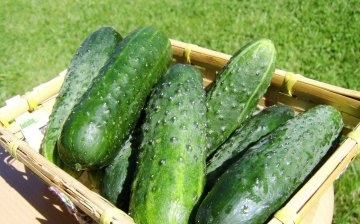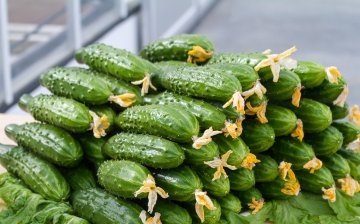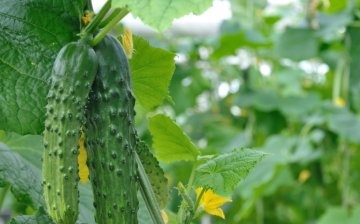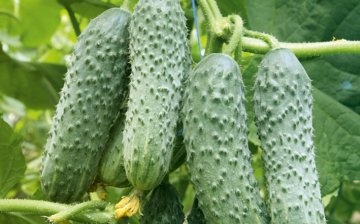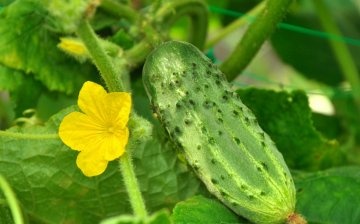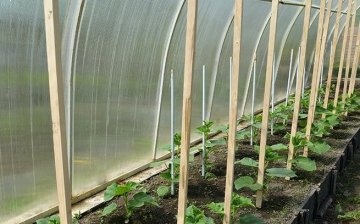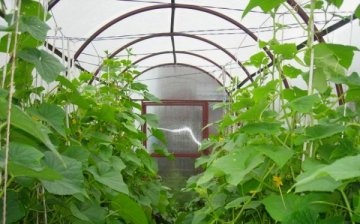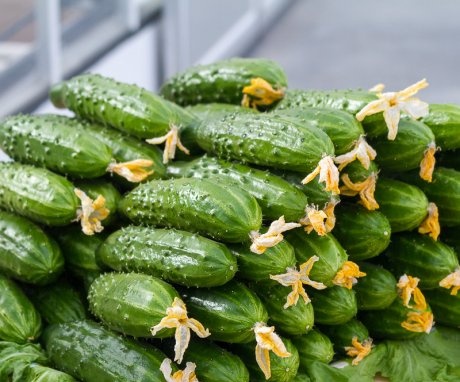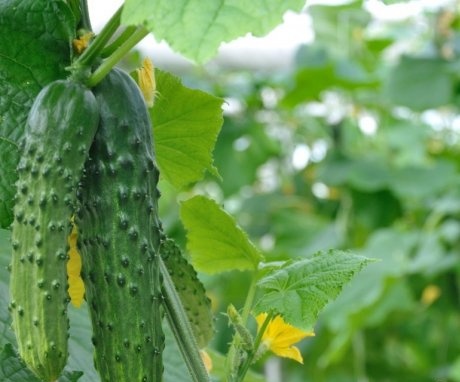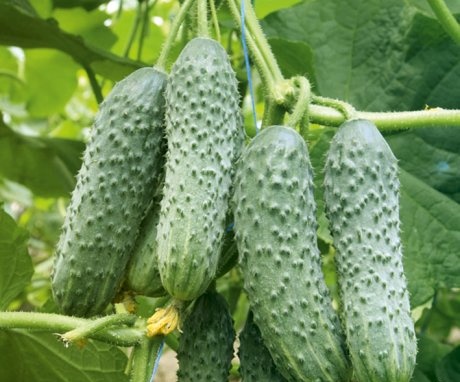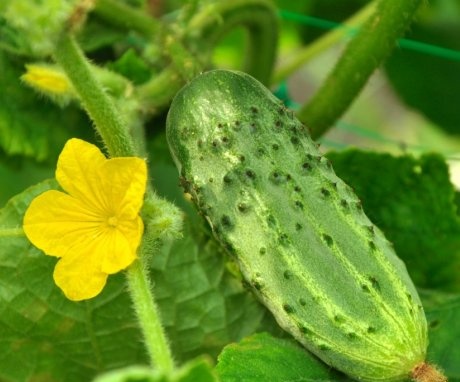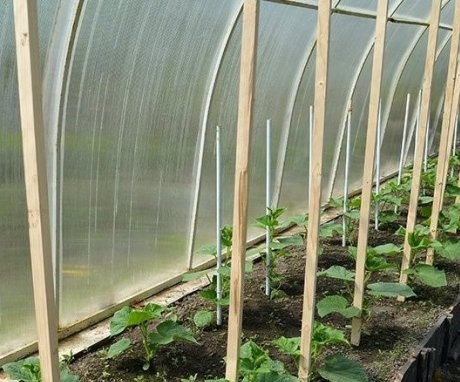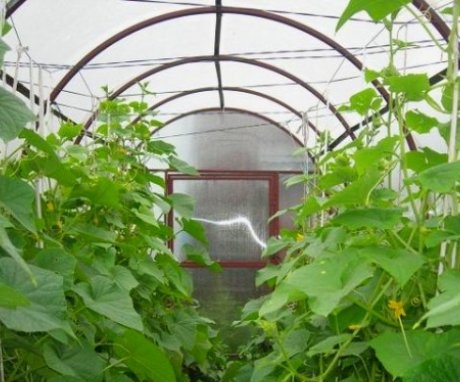The best varieties of cucumbers for greenhouses
Cucumber is one of the most popular vegetables. They are salted and pickled, salads are prepared. They are especially tasty when fresh. Grow fresh cucumbers all year round it is possible in greenhouses.
Content:
- Greenhouse cucumbers
- Early maturing varieties of cucumbers for greenhouses
- Mid-ripening and late-ripening varieties
- Dutch varieties for greenhouses
- Planting cucumbers in the greenhouse
Greenhouse cucumbers
Most varieties of cucumbers require pollination by bees. It is after they transfer the pollen from the male flower (barren flower) to the pistil of the female flower that the ovary appears, from which the cucumber grows. But in a greenhouse, pollination by bees is only possible during the summer months. To be able to grow cucumbers without the help of insects, parthenocarpic or self-pollinated varieties have been invented. There are no seeds at all inside the fruits of parthenocarpics. It is not necessary to pollinate flowers of such varieties. After pollination by bees, cucumbers are crooked. The flowers of self-pollinated varieties have a pistil and stamens. Bees are not needed for pollination.
Benefits of parthenocarpic or self-pollinated hybrids:
- High productivity.
- Resistant to most diseases.
- Bears fruit without bees.
- Most varieties are not demanding on lighting.
- Resistant to temperature extremes and other stresses.
Such varieties also have a drawback: they will not be able to collect seeds for next year. Parthenocarpics do not have them, and the seeds of self-pollinating hybrids do not retain the properties of the parent variety. Therefore, you will have to buy new ones every year or purchase for future use, taking into account the expiration date.
Types of cucumbers for greenhouses by purpose:
- Salad are distinguished by a smooth skin, the absence of thorns. Sometimes they are, but subtle and delicate. The skin is very firm. Such varieties are not harvested for the winter. Their advantage is good transportability.
- Canned cucumbers with firm flesh.
- Universal can be used in salads and prepared for the winter. They look like black or brown spines.
Early maturing varieties of cucumbers for greenhouses
The difference between early and super early varieties is only 5-10 days. Therefore, it is sometimes difficult to determine which group the variety belongs to:
- Advance payment is a super early variety of universal purpose. Fruits appear as early as 39 days after the shoots appear. Cucumber weight from 120 g.
- Pinocchio F1, a variety of universal use, has small fruits 7 cm long. Very early. Productivity up to 12 kg / m2. Recommended for small greenhouses.
- April F1 starts bearing fruit after 45 days. after emergence. The weight of one fruit is from 200 g. The yield reaches 20 kg / m2. Salad variety.
- Angelina is a very early large-tuberous hybrid with fruits 14 cm long tolerates insufficient lighting.
- Christina F1, Delpina F1, Capra F1 - early ripening parthenocarpic gherkins.
- The square dance is a very productive hybrid-parthenocarpic with universal purpose. Can be grown in polycarbonate and film greenhouses, because it is not afraid of dropping temperatures.
- Zozulya F1 ripens 42 days after germination. The fruits are long, each weighing more than 200 g. The yield per square meter reaches 15 kg. The variety is great for making salads. Bears fruit for a long time.
- Zyatek F1 - a variety of universal purpose. You can harvest 45 days after germination. The weight of one fruit reaches 100 g, and up to 10 kg of cucumbers are harvested from a square meter.
Mid-ripening and late-ripening varieties
Middle and late varieties differ from early varieties in high yields. From one square meter, you can collect 25 kg of medium cucumbers and about 30 kg of late varieties:
- Courage - a mid-season self-pollinating hybrid. The first small tuberous fruits weighing 180 g can be removed after 55 days. Some sources call it early.
- Cupid is a self-pollinated hybrid. Gherkins appear 50 days after germination. They are smooth, without bitterness, pleasant to the taste. Used fresh and for pickling.
- Ginga is similar in type and taste to "Amur"
- Claudia F1 is a hybrid with long lashes. Zelentsy up to 10 cm long with small tubercles are harvested on the 55th day after germination.
- Hercules F1 is a salad variety of late fruiting. From germination, it takes at least 62 days before you can harvest. Fruits are spindle-shaped of medium size, from 150 g, length up to 15 cm. Their thorns are white. Not affected by cucumber mosaic, olive spot. Requires artificial pollination.
- White Angel F1 - average fruiting period, about 50 days. Fruits of white color between green cucumbers look original in jars. Fruit length up to 7 cm, if they grow longer, they become tasteless. The average number of tubercles is white. The pulp is firm. Productivity up to 15 kg / m2.
- Crystal - has large lumpy fruits up to 20 cm long, cylindrical in shape. Weight of one up to 150 g. Productivity up to 30 kg / m2.
Varieties that can be grown in winter greenhouses under glass:
- Surprise 66 of a very unusual shape and color. Fruiting occurs 100 days after germination. The fruits can grow up to 1 m, but then they will not be tasty. They are removed after they grow to 20 cm. There are no bumps on the surface of the cucumber, instead there are longitudinal stripes. Salad look of cucumbers.
- Moscow hothouse is a mid-season variety. Fruiting 80-96 days after germination. Productivity is about 3 kg / m2. Cucumber length up to 40 g, weight more than 300 g.
Marfinsky, Regatta, Domashniy, Iva withstand insufficient lighting best of all. They tolerate a violation of the irrigation regime, insufficient air humidity.
Dutch varieties for greenhouses
Many gardeners use Dutch varieties for growing in a greenhouse. Although many people think that they are not very tasty, they have a number of advantages:
- Good germination.
- High productivity.
- Lack of bitterness in fruits.
- Disease resistance.
- Self-pollination (most varieties).
Cucumber varieties:
- Angelina is a self-pollinating super-early variety with long, up to 14 cm, cucumbers. The advantage is that it can grow and bear fruit in low light conditions.
- Hector F1 is an early universal cucumber variety of dark green color. The fruits are small, crunchy, do not turn yellow for a long time.
- Bettina F1 - early ripe gherkin with cylindrical fruits of delicate taste. Parthenocarpic, which tolerates a lack of light.
Planting cucumbers in the greenhouse
Seeds are hardened before planting. This increases immunity to disease. A piece of gauze is moistened, the seeds are wrapped in it, they are placed in a refrigerator for 2 days, the temperature in which should be within 2-5 ° C. After hardening, the seeds are placed in a solution of trace elements and kept for 12 hours. This can be an infusion of onion husks or ready-made mixtures (Uniflor Micro).
In unheated greenhouses, 25-day-old seedlings are planted at the end of May.
The soil temperature must be at least 14 ° C. Planting density depends on the type of cultivation. If the plants are spread on the ground, then up to 4 plants are planted per square meter. When grown on trellises, 1-2 plants are enough. If seeds are sown rather than planted seedlings, the seeds are immersed to a depth of 2 cm.
The cultivation process for Dutch varieties is slightly different from the usual ones.
- Seeds are sown in pots in rows, the distance between which is from 2 cm.Buy peat cubes or prepare them yourself, filling them with a substrate made from peat, humus, sand and garden soil.
- The hatched seedlings dive into cubes, watered. The amount of light at this time should be maximum, and the temperature should be slightly lowered. Spray with water at room temperature.
- While the seedlings are growing, trenches are dug in the greenhouse at a distance of at least 80 cm. The depth is about 40 cm. A thick layer of manure is laid at the bottom of the trenches, sprinkled with earth. Seedlings are planted in squares with a side equal to the distance between the rows.
- The soil in the greenhouse should be fertile, loose, and allow water to pass through well. The acidity is neutral. You can add rotted coniferous sawdust, peat chips, humus.
- Late varieties of cucumbers are planted in one row. With this arrangement, they will not shade each other, which is very important if there is not enough light in September-October.
Care Tips
The microclimate in the greenhouse should be stable, temperature and humidity should not change dramatically. The optimum temperature will be from 12 to 35 degrees. Humidity 85 to 90%. Water temperature for irrigation is 25 degrees. Bushes are formed depending on the form of cultivation. When located on trellises with a height of about 2 m, the side branches are placed horizontally, the excess ones are pinched.
After the plant takes root and begins to grow, the first 3 antennae are cut off.
For watering use drip irrigation systems... They also allow for liquid feeding. They are fed 3-4 times a month. First time at the beginning of fruiting. Potassium chloride and potassium salt are not used. Cucumbers do not tolerate them well. Before and after feeding, watered with clean water.
Hybrids are weakly affected by fungal diseases. But in cold weather, they can develop and destroy plants. In order to prevent this from happening, the plants are constantly examined. You can do this at harvest time. When brown spots appear on the leaves or their darkening, skim milk is diluted in water in equal parts and the plants are watered at the rate of 1.5 liters for each. When watering and feeding, water must be poured so that it does not fall on the stems and leaves of plants.
If signs of illness appear powdery mildew (the leaves are covered with a white bloom, which eventually becomes brown), the cucumbers are treated with Trichodermin. It is not a chemical, so the fruit can be harvested and eaten.
Every morning varieties of late fruiting are watered with water at a temperature of 25 ° C. In warm weather, 4 liters of water are added per square meter of area. After the inflorescences fall off, you need to pour out 10 liters. After the temperature drops, the number of waterings is reduced to 1-2 times a week. The rate is 10 liters per m2. They feed at least 1 p per week. You can use a fermented herbal infusion. Dilute 1 liter in a bucket of water, pour 1 liter of the resulting liquid under the bush. The roots of the late varieties are mulched to protect them from the cold. To do this, lay a layer of humus 10 cm thick.
More information can be found in the video:



